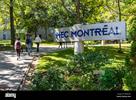JOPT2025
HEC Montreal, 12 — 14 May 2025
JOPT2025
HEC Montreal, 12 — 14 May 2025

OR for Better Africa II
May 14, 2025 02:00 PM – 03:40 PM
Location: BMO (Green)
Chaired by Mohamed Faouzi Benammour
4 Presentations
-
 02:00 PM - 02:25 PM
02:00 PM - 02:25 PMEarly Ventures Contests via Quantilized Mean Field Games.
We present a model involving a large number of finitely many homogeneous agents engaged in competitive early ventures over a finite time horizon. In this model, only a select proportion of top-performing agents will advance to the next round at the end of the time horizon. Assuming that the number of agents is infinite, we conceptualize these early ventures contest as a quantilized mean field game, which are generalizations of mean field games where the mean field term is a quantile of the empirical distribution. Two versions of the problem are solved, one analytically and the other numerically. We solve analytically the most regular version of the problem, and show that numerically, it is a good approximation of the second version of the problem. Finally, we show that the analytic mean field game solution provides an approximate Nash equilibrium for the finite game. This is joint work with Dena Firoozi and Michèle Breton.
-
 02:25 PM - 02:50 PM
02:25 PM - 02:50 PMThe cost of modelling silicon-based materials with machine learning potential.
The emergence of machine learning potential has revolutionized material modelling, yet its development involves thousands of quantum mechanical calculations. These calculations, along with potential training and molecular dynamic simulations, require substantial computational resources. In this study, we aim to elucidate the resource consumption involved in developing machine learning interatomic potential for silicon-based materials modelling. The consumption data presented here are extracted from the Digital Research Alliance of Canada account, automatically saved over four calendar years by their internal computation system. This model is the start of a model aiming to represent construction materials.
-
 02:50 PM - 03:15 PM
02:50 PM - 03:15 PMRégression sur motifs spatiaux pour les données météorologiques spatialisées
Les ressources en eau sont fortement affectées par les changements climatiques, notamment à travers l'apparition croissante d'événements météorologiques extrêmes (comme les inondations). Pour étudier les impacts de ces changements, des modèles hydrologiques souvent alimentés par des données de précipitations et de température spatialisées (c'est-à-dire disponibles sur une grille régulière) sont utilisés. Une façon courante d'obtenir ce type de données qui doivent tenir compte des événements extrêmes et de l'hétérogénéité spatiale est d'utiliser des méthodes d'interpolation spatiale. Les méthodes d'interpolation spatiale les plus courantes utilisées telles que la pondération inverse de la distance et le krigeage ordinaire sont limitées par des effets isotropes qui ne leur permettent pas de prendre en compte la variabilité spatiale. Certaines extensions de ces méthodes (krigeage avec dérive externe) utilisent des informations auxiliaires (altitude, climatologie) pour compenser la faible densité du réseau de stations. Dans ce travail, nous proposons une nouvelle méthode pour estimer des données météorologiques spatialisées. Dénommée \textit{Spatial Pattern Regression (SPR)}, elle exploite exclusivement et systématiquement les motifs spatiaux pour interpoler les observations. Les motifs spatiaux sont extraits des données des modèles climatiques régionaux en utilisant l'analyse en composantes principales. Cette méthode permet de garantir la cohérence des informations spatiales utilisées dans les périodes passées et futures dans la modélisation hydrologique. La SPR est appliquée aux précipitations, aux températures minimales et maximales dans différents cadres contrôlés (taille de la région, variabilité climatique, densité du réseau de stations) pour analyser les effets de ces facteurs sur les performances des estimations. Comparés aux méthodes existantes les plus utilisées, les résultats montrent que SPR dispose de meilleurs performances quantitatives et qualitatives selon plusieurs facteurs.
-
 03:15 PM - 03:40 PM
03:15 PM - 03:40 PMAutomated Metaheuristic Approach for Solving the NP-hard RFID network planning problem
The deployment of radio frequency identification (RFID) technology in a large-scale environment generates a network planning problem (RNP) which is considered as an NP-hard, non-linear, combinatorial optimisation problem with a large number of uncertain variables and parameters by adjusting several control variables for which it aims to optimise a set of objectives such as coverage, redundancy, interference, and load balance. This study explores the potential of solving the RNP problem by introducing a novel automated approach based on a metaheuristic inspired by artificial neural networks, called I-RAENNA, using machine learning methods to extract useful information in order to stimulate and improve search performance by initialising only the maximum number of iterations. This study, contrary to previous studies, indicates that automating the initial parameters and avoiding arbitrary choices owing to Machine Learning methods based on statistical tests makes it possible to produce more accurate, cost-effective, and efficient solutions. Furthermore, the results obtained by I-RAENNA outperform advanced state-of-the-art approaches by easily satisfying the objectives of the RNP problem and demonstrating its ability to produce perfect RFID system deployment.
